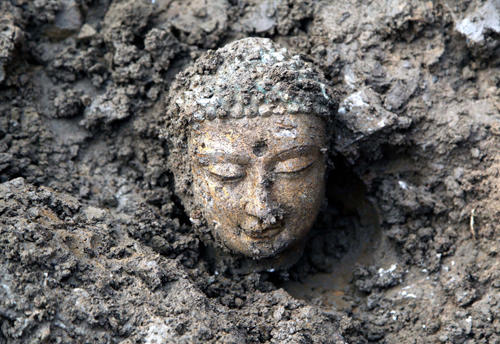|
 |
|
A SACRED STATUE: The head of a Buddha statue is unearthed at the Yecheng Relics Site in January (CFP) |
Fourth, judging from the descriptions and characters, a large number of these Buddha statues might have been crafted in 534-577, with a small number of bluestone pieces between 386-557, and only a few fashioned in the early Tang Dynasty (618-907). The relics spanned about 300 years of Chinese history. Moreover, the date marks on them are very clear, providing a large amount of credible evidence for archeologists to study the development of Buddhism in China.
Though a lot of fieldwork has been accomplished, there are still many mysteries for archeologists to resolve. For instance, are the relics associated with any temples or social or cultural movements in ancient times? What clues can the relics provide for further excavation of Yecheng?
However, one of the most important and urgent tasks at present is to save and rearrange these valuable pieces. Zhu said, "The Institute of Archeology of the CASS is making a detailed plan to settle the issue. The local government plans to build a museum to permanently preserve these relics."
Though it is unknown to most people today, Yecheng was an ancient capital city in north China, witnessing the rise and fall of numerous dynasties in the Chinese history. The city was first built on a large scale in 204, during the late Eastern Han Dynasty (25-220) by Cao Cao (155-220), a well-known feudal warlord. Afterward, Yecheng became an important political and cultural center of the subsequent dynasties.
The Cultural Relics Bureau of Linzhang County disclosed it will create a Buddhist cultural park at the Yecheng Relics Site.
The cultural park, which is expected to cover 107 hectares, will include a museum, a Buddhist school, temples as well as hotels and shops for tourists.
Yang Hong, a research fellow of the Institute of Archeology at the CASS, explained that there are two principal theories for the burial of a large number of Buddha statues in a single pit. One is the demolition and desecration of Buddhist artifacts and the other is the storage of Buddha statues for sacred or religious purposes.
"According to current evidence, all the statues were placed in a disorderly fashion and most of them were broken, so the Buddha relics in Yecheng are probably the result of organized desecration efforts," Yang said.
Buddhism in Ancient Yecheng
Buddhism was introduced to China from India during the late Western Han Dynasty (206 B.C.-A.D. 24). The religion gradually gained a foothold in China and became the prevalent religion following the Northern Wei Dynasty. In 557, the Northern Wei Dynasty was split into two regimes, Eastern Wei and Western Wei. Yecheng became the new capital of Eastern Wei and its successor Northern Qi. Many imperial temples were moved to the new capital. The popularity and influence of Buddhism reached a peak and Yecheng served as the center of Chinese Buddhism during that period.
Nevertheless, Buddhism was also repressed during several historical periods. The power of the Buddhist clergy was seen as a threat by several ruling emperors, and the religion's philosophy clashed with Confucian teachings. There were three big anti-Buddhist demolition movements launched around the periods of A.D. 450, 550, and 800.
Yecheng was sacked and leveled in 580 by Yang Jian (541-604), the founding emperor of the Sui Dynasty (581-618). Though Yecheng has declined since then, this latest archeological find attests to its past glory.
Email us at: baishi@bjreview.com | 